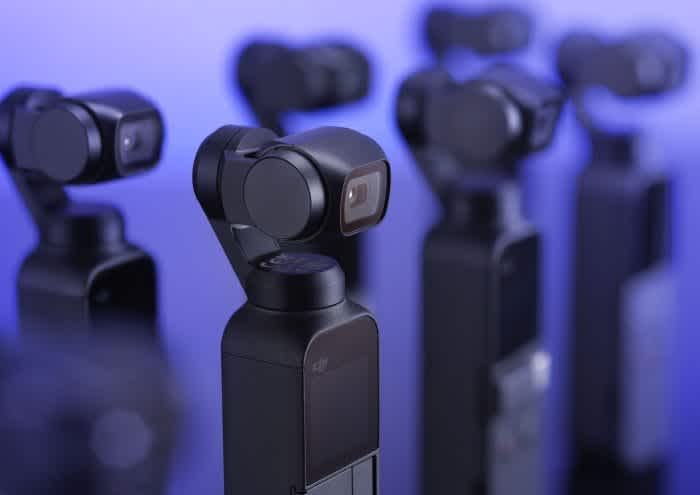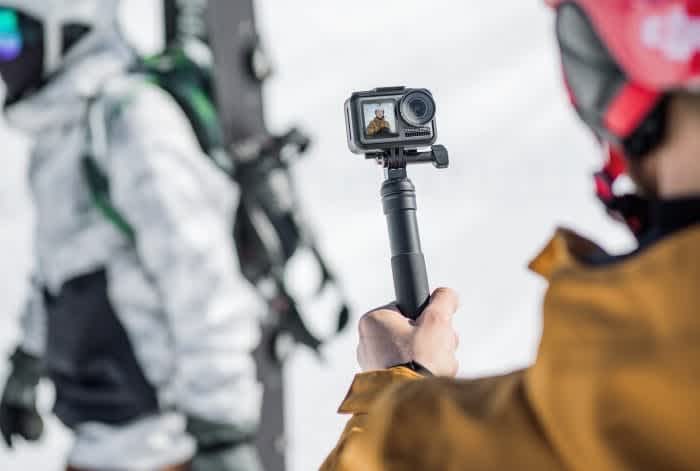
Updated on 17 Sep 2024
DJI Osmo Action v DJI Osmo Pocket
An in-depth guide to the DJI Osmo Action and DJI Osmo Pocket, to help you decide which one is best for you. ... Read More
Think of DJI and quite often drones come to mind. But recently, two of the company's most anticipated new releases have been hand-held cameras - namely the Osmo Pocket and the Osmo Action.
The Pocket was a big hit when it was unveiled just before Christmas last year, with this teeny-tiny device boasting three-axis stabilisation technology.
But last month, DJI introduced an Osmo Pocket alternative; this time entering the action-camera market with the Osmo Action - a rival to the GoPro HERO7 Black.
Both the Pocket and the Action are portable, high-performance cameras which pack a wealth of intelligent features and help you capture memorable moments in high detail.
Purchase the DJI Osmo Pocket and the Osmo Acton from Heliguy
With this in mind, which one is better suited to meet your needs? In this Heliguy Insider blog, we'll take an in-depth look at their specifications and test them side by side, helping you make an informed decision.


Osmo Action v Osmo Pocket - Specifications
First of all, let's take a quick look at some of the key specifications of both cameras.
Osmo Pocket | Osmo Action | |
Dimension | 121.9 x 36.9 x 28.6mm | 65 x 42 x 35mm |
Weight | 116g | 124g |
Operating Time | 140 minutes (When shooting 1080p/30fps video) | 135 minutes (When shooting 1080p/30fps without RockSteady) |
Charging Time | 73 minutes | 90 minutes |
Operating Temperature | 0-40°C (32°-104°F) | -10°C-40°C (14°-104°F) |
Audio Output | 48 KHzAAC | 48 KHzAAC |
Price | £329 | £329 |
Osmo Action v Osmo Pocket - Stabilisation
Perhaps one of the most important aspects of both cameras is the image stabilisation.
Osmo Pocket uses DJI's smallest three-axis mechanical handheld gimbal. In real time, it precisely adjusts for your movements, helping to capture very smooth footage.
Osmo Action provides shake-free footage thanks to DJI's RockSteady, an advanced technology that features a combination of Electronic Image System and complex algorithms.
To test the stabilisation, we took both cameras to Jump 360 indoor trampoline park, in Longbenton, Newcastle-upon-Tyne, putting them through their paces on the Ninja Assault Course. We also had a walk around Durham. Here are the results.
Ninja Assault Course
Handheld video with DJI Osmo Action and Osmo Pocket
Durham
As you can see, both cameras do a decent job at stabalising the images and produce decent image quality.
On one of our tests though - bouncing on a series of trampolines - the Osmo Pocket didn't cope well with the up and down movement, with the sensor panning up to and staying focused on the ceiling.
Osmo Action v Osmo Pocket - Performance
Both Osmo Pocket and Osmo Action house high-performance cameras with 1/2.3-inch sensors that can shoot 12-megapixel images and 4K videos at 60fps. The ISO range of both cameras is 100-3200, whether you’re capturing photos or video.
As an added bonus, the Action is also capable of shooting HDR videos. This technology helps to deliver natural transitions between light and dark areas and capture rich details which are often lost in environments with complex lighting.

Field of View
The field of view (FOV) is wider on the Osmo Action (145°), compared to the 80° on the Osmo Pocket.
However, while the Pocket has a smaller FOV, it does have smart modes which help to keep you in the frame; especially useful for vloggers.
ActiveTrack allows the camera to follow the selected object with smooth movements thanks to its three-axis gimbal.
When using selfie mode (FaceTrack), Osmo Pocket detects a human face within the frame and continually tracks it.
Meanwhile, on the Osmo Action, a Dewarp function eliminates distortion when shooting close-ups, erasing any potential fish-eye effect which could be the by-product of a wider FOV.
Creative Shooting Modes
Another excellent feature available on both cameras is being able to capture footage in slow motion. There are differences in what can be achieved though.
The Pocket is capable of 4x slow-mo - suitable for capturing the nuances of quick movements that can't be appreciated at normal speed - but the Action can go even further, with an 8x slow-mo with 1080p resolution and 240fps frame rate - perfect for a more powerful capture of your most intense moments.
When it comes to other creative shooting modes, both cameras have a range of options.
Osmo Action and the Pocket support Timelapse - perfect for squeezing a beautiful day into a single shot and turning hours into seconds. In addition, the Pocket features Motionlapse, which adds smooth camera movement for dramatic effect.
For taking long exposure shots, Osmo Pocket’s shutter speed can be set to eight seconds. Osmo Action provides the ability to slow down the shutter speed up to 120 seconds, perfect for capturing a night sky full of stars.
SnapShot
Adventure can happen at any time, so with this in mind, the Osmo Action boasts a SnapShot feature which allows you to press the shutter button to power on and start recording in under two seconds.
The Osmo Pocket doesn't have this luxury, but while it is not quite as rapid as the Action, the activation speed of the Pocket is still okay, as the video below shows.
Voice Control
Another great feature of the Osmo Action is the ability to shoot hands-free, thanks to the voice control function. This handy feature allows you to carry out five essential functions just be saying the commands out loud. These are:
Start recording
Stop recording
Take photo
Screen switch
Shutdown
Battery Life
The Osmo Pocket battery life is 140 minutes (when shooting 1080p/30fps video) while the Osmo Action battery life is 135 minutes (when shooting 1080p/30fps without RockSteady) .
While the Pocket can go for slightly longer and is quicker to charge (73 minutes compared to the Action's 90 minutes), the Action has a removable battery, meaning that you can take spares to ensure you have enough power for an entire shoot.
The Osmo Pocket, on the other hand, has a built-in battery. If it gets drained, you can only continue to shoot if you plug it in to a USB cable.
DJI Mimo App
For more advanced control, you can connect Osmo Pocket to your smartphone, either through its universal adapter or with the Wireless Module. This allows you to use DJI Mimo to control the camera, adjust parameters, change settings, and access advanced capture features.

Like Osmo Pocket, Osmo Action is also supported by the DJI Mimo app. You can connect Osmo Action with mobile devices wirelessly through Wi-Fi or Bluetooth without any added accessories.

Osmo Action v Osmo Pocket - Design
Both cameras have the same size sensors (1/2.3 CMOS), but the Osmo Action is the winner when it comes to screens.


The Action has two screens, each larger than the Osmo Pocket. So what can the Action's dual screens do?

Back screen: A 2.25-inch touchscreen for camera view, setting adjustments, shooting modes and playback.
Front screen: A 1.4-inch screen showing a live camera view, perfect for capturing selfies. This is a super-cool feature, making vlogging easier than ever before.

The Osmo Pocket features a 1.08-inch back screen. This is touchscreen and can be used to change a variety of settings and view the action.

As an added bonus, the Osmo Action's lens and back screen are covered in a protective, anti-fingerprint coating that repels oil, water, dirt, and other small particles, making it far more durable than the Osmo Pocket.
Speaking of water, another string to the Osmo Action's bow is that it can be taken to depths of up to 11metres underwater without added accessories, or down to 60 metres with a diving house. The Osmo Pocket can also be taken to 60 metres with a waterproof case.

Osmo Action v Osmo Pocket - Conclusion
So, which Osmo is better for you?
Put simply, it seems to boil down to what you are wanting from your camera.
If you are an adrenaline junkie, then look no further than the Osmo Action. Features such as its waterproof design, ability to shoot in lower temperatures (-10°C compared to 0°C for the Pocket), voice control functions and super-smooth image stabilisation make it the perfect companion for outdoor enthusiasts and high-octane activities.

On the other hand, the Osmo Pocket is an ideal choice for vloggers and videographers who aren't looking to capture such action-packed scenes. The quality camera ensures cinematic images and footage, optimised by a range of easy-to-use modes, such as Timelapse, Motionlapse and slow-motion, plus you can go to depths of 60m with the waterproof case accessory.
Both cameras are available from Heliguy, as are a range of accessories for each.

written by
James Willoughby
James joined heliguy™ in 2018 following a 13-year stint in print and online journalism, having worked on regional and weekly newspaper titles. He is responsible for spearheading heliguy™'s content strategy and social media delivery. James collaborates with DJI Enterprise's European marketing team to coordinate and produce case studies and helps organise events and webinars.